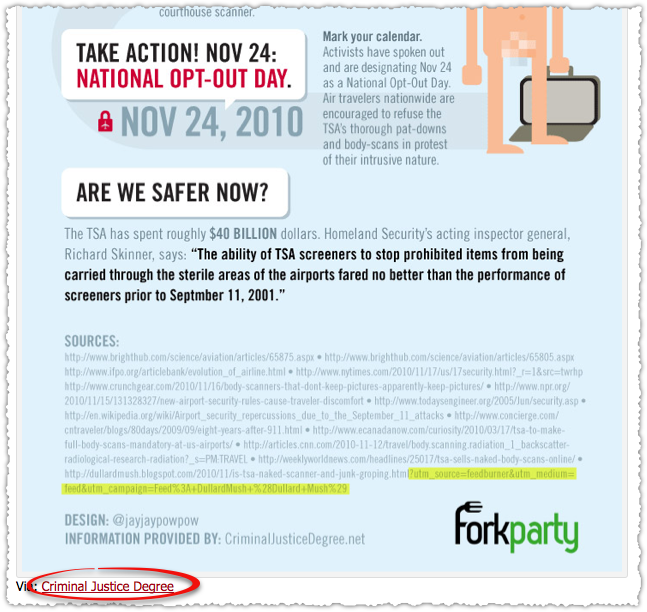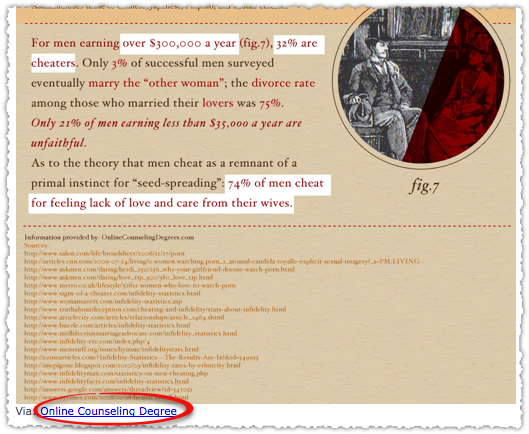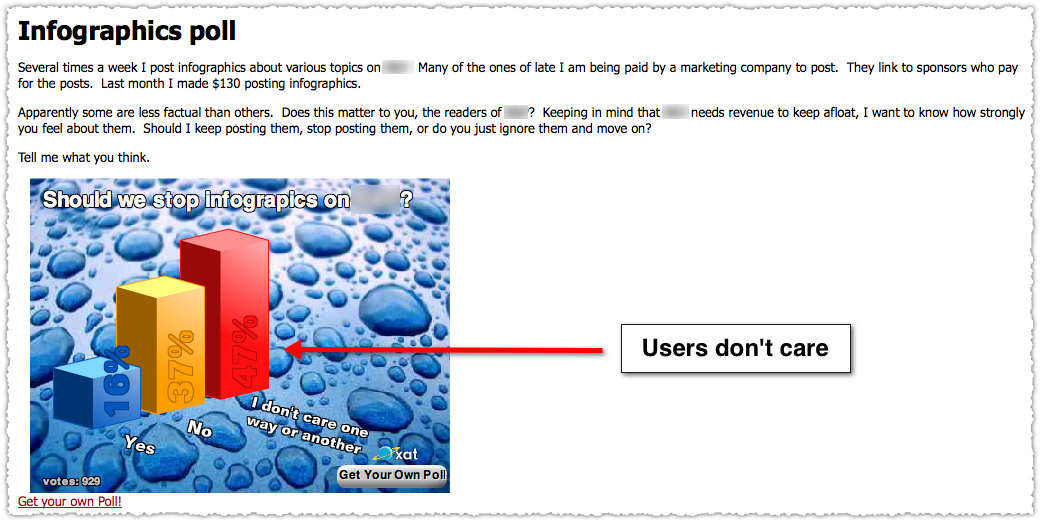Infographics can be a great way to generate backlinks. But the prevalence of infographic spam threatens this link building technique.
Infographic Spam
You’ve undoubtedly seen infographic spam. The hallmarks of infographic spam are a mediocre graphic from multiple data sources with a link back to a tenuously related website.

This TSA infographic is linked to a criminal justice degree site. Related? Barely. Of note, nice going keeping the utm parameters in your source link.

Here’s one about the sexual revolution that’s linked by to a site offering online counseling degrees. Related? No.
Pay per Infographic
Oh, did I mention that they pay sites to post infographics? Earlier this year Aaron Wall wrote about link buyers outing themselves. Well here’s a similar example.

This is an actual post where the site owner admits to posting infographics for money and asking if readers mind. The verdict? Readers are fine with it. But I’m not, and neither should you.
The sites that generate this garbage are usually making a lot of money – most often coming from the lucrative education vertical. But what about this guy? What about the individual site owner? He’s making just $130. I don’t blame the guy really. He’s just trying to break even on this site and maybe make a little bit in the bargain.
Paid Links vs Paid Infographics
In my mind, there is a big difference between paid links and paid infographics. Paid links are essentially static. You’re renting the trust and authority of that site and probably getting a bit of traffic as well. There’s no expectation of amplification. Said another way, paid links aren’t viral.
Paid infographics are problematic because they are engineered to create additional installations through social distribution and embeds.

The sole purpose of infographic spam is to drive keyword specific anchor text from multiple domains. Domain diversity anyone?
In addition, when buying links you’re usually looking for links from sites that are similar in topic. You’re seeking to build your profile in a certain neighborhood.
As an aside, this is exactly what you’re doing if you buy a directory listing. You’re buying the trust and authority from a relevant section of that directory. I’m still not sure why one is verboten and the other is okay, but that’s a topic for another post. While I don’t actually recommend buying links, I don’t find the transaction to be that disturbing.
Nevertheless, there’s no such targeting involved in paid infographics. It’s the Sherman’s March of link building.
Algorithm Blues

It doesn’t seem like the algorithm is currently capable of finding infographic spam. I can completely understand why it might be difficult.
The link graph may not be that different for paid and non-paid infographics. Because once an infographic gets out in the wild, the viral component takes over. Users don’t care about the little bit of HTML at the bottom of the infographic, they just think it’s interesting. As the poll above showed, even when told, users aren’t running to Google to file a spam report.
You can’t use anchor text bombing as a signal since any good SEO is going to use proper anchor text in an infographic.
Now, perhaps you could work to determine whether the source sites (where it first appeared) between infographics differed. Yet, the example I provided mentions that ‘many’ of the infographics posted of late were paid. So, he might be mixing in ones found and enjoyed with ones where he’s getting paid. So is his site a poison source site or not?
In the end, maybe we need a little human intervention and outreach. A couple of emails, a bit of sleuthing and some Law & Order type of immunity deals and I think you’d locate the sites and intermediaries who were polluting the infographic space. I’m not advocating going after the posting sites or contract designers but instead the sponsors of this content.
Am I entirely comfortable with Google using their nuclear option (the dreaded penalty) in this type of subjective manner? No. But lately I’m seeing way too much getting through the algorithm (both infographic and otherwise) and relying on users to report spam doesn’t seem like enough.
Do you care about infographic spam? If so, what would you do to stop it?
The Next Post: SEO Metrics Dashboard
The Previous Post: Dynamic Keyword Insertion and Quality Score

Comments About Kill Infographic Spam
// 3 comments so far.
Ryan // October 04th 2011
looks like nobody cares one way or the other…
Apathy is the great killer…but I just can’t foresee casual internet users getting that annoyed at people for accepting money for posting pretty colors on a webpage in exchange for a tiny link at the bottom…
As far as spam goes, this is the least annoying method I’ve ever heard of…one might even say it would be kind of cool if more spammers took the time to make pretty inforgraphics to get links.
It beats the hell of out pesky x-rumer forum spam.
Bottom line: I think you need to let this one go.
AJ Kohn // October 05th 2011
Ryan,
Thanks for reading and for your comment. I agree that most readers don’t care, even when they’re told that it’s a pay per post arrangement.
The medium isn’t as bad as the x-rumer forum spam, that’s for sure. But these are paid links at the end of the day, but paid links with the express purpose of generating downstream viral links. That’s what bothers me most, in part because the people getting paid to post these things are getting a bum deal based on that amplification.
Ryan // January 25th 2012
good point…I guess it’s a deception all the same…
Links aside, even if it doesn’t go viral it does spread bad and poorly resourced information.
Which is probably the exact reason people have a misconception about SEO.
Sorry, comments for this entry are closed at this time.
You can follow any responses to this entry via its RSS comments feed.